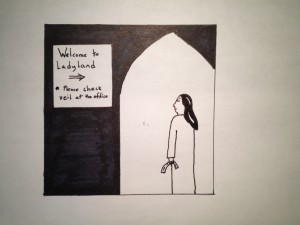Week 12
In week 12 we read two interesting pieces. One was a short story published in 1905 by an Indian woman named Rokeya Skhawat Hossain. The story focuses on the utopia of Ladyland, an imagined state where women are the dominant gender. They are the guiding authority in all matters. A queen rules the state who emphasizes the importance of education, knowledge, and scientific advancement. These policies have lead to the proliferation of wonderful inventions which ease the lives of all citizens. Men, who are confined to the house, are quiet and timid.
Persepolis is an autobiography that tells the story of a young Iranian girl growing up during the Iranian revolution. Author Marjane Satrapi tells of the apparent reversal of fortunes for women in Iranian society. It had seemed for a while that their lot was improving, but 1980 brought changes based on fundamentalist teachings of Islam. One of the points of contention involved the wearing of veils. Support for the veil became a symbol of those who supported more traditionalist roles for women in society while protest against the veil symbolized the more modern liberal hopes of women.
After reading the two stories, I couldn’t help but imagine how Marjane would enjoy a visit to Ladyland. To make the two narrative meet in one frame, I opted to use the graphic novel medium employed by Satrapi in Persepolis. I draw an imagined scene where Marjane is walking through an archway into Ladyland. The sign on the wall calls for visitors to check their veils at the front office. Marjane stands in front of the archway reading the sign, veil in hand, and she is smilling.
